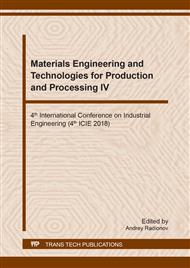[1]
N.A. Semenko, L.I. Kuperman, S.A. Romanovsky, N.M. Itskovich, L.N. Sidelkovsky, L.K. Vukovich. Secondary energy resources and energy-technological combining in industry, Kyiv, (1979).
Google Scholar
[2]
Shargut Ya. Heat power engineering in metallurgy, Moscow: Metallurgiya, 1976, 152 p.
Google Scholar
[3]
Shakhova V.I., Pinchuk S.I. Recoverable resources of metallurgy. Dnepropetrovsk: RIA Dnepr-VAL,, (2009).
Google Scholar
[4]
Reference book of heat power engineering of non-ferrous metallurgy enterprises. Edited by O.N. Bagrov and Z.L. Berlin, Moscow, Metallurgiya, (1982).
Google Scholar
[5]
B.I. Basok, Yu.L. Kurbatov, A.B. Biryukov, E.V. Novikova, Heat power engineering of metallurgical production: study guide, Donetsk: State Higher Educational Institution DonNTU,, (2013).
Google Scholar
[6]
B.V. Sazanov, The use of secondary energy resources at metallurgical plants, Moscow: Metallurgizdat, (1953).
Google Scholar
[7]
S.V. Lukin, N.S. Tumanova, Cooling and heating of impulse air before PGU-420 at Cherepovetskaya SDPP, using the heat exchangers of the air filter house, Cherepovets State University Bulletin, 1 (2017).
DOI: 10.23859/1994-0637-2017-1-76-8
Google Scholar
[8]
V.M. Neuimin, G.G. Latypov, I.N. Krykin, Improving the efficiency of gas-turbine power plant by air cooling in compressor, using absorption refrigerating machines, Reliability and safety of power engineering, № 3 (30) (2015) 61-67.
Google Scholar
[9]
Shahrul Nahar Omar Kamal, Didi Asmara Salim, Mohd Sahril Mohd Fouzi, Danny Tam Hong Khai, Mohd Kamarul Yusri Yusof. Feasibility Study of Turbine Inlet Air Cooling using Mechanical Chillers in Malaysia Climate, Energy Procedia, 138 (2017) 558-563.
DOI: 10.1016/j.egypro.2017.10.159
Google Scholar
[10]
Mahmood Farzaneh-Gorda, Mahdi Deymi-Dashtebayaz. Effect of various inlet air cooling methods on gas turbine performance, Energy, 36(2) (2011) 1196-1205.
DOI: 10.1016/j.energy.2010.11.027
Google Scholar
[11]
Y. Zhang, W. Shi, Y. Zhang, From heat exchanger to heat adaptor: Concept, analysis and application. Applied Energy, 115 (2014) 272-279.
DOI: 10.1016/j.apenergy.2013.11.015
Google Scholar
[12]
Y. Li, L. Fu, S. Zhang, Y. Jiang, Z. Xiling, A new type of district heating method with co-generation based on absorption heat exchange (co-ah cycle). Energy Conversion and Management, 52(2) (2011) 1200-1207.
DOI: 10.1016/j.enconman.2010.09.015
Google Scholar
[13]
J. Sun, L. Fu, S. Zhang, Experimental study of heat exchanger basing on absorption cycle for CHP system. Applied Thermal Engineering, 102 (2016) 1280-1286.
DOI: 10.1016/j.applthermaleng.2016.03.138
Google Scholar
[14]
A.V. Volkov, I.V. Yavorovsky, A.S. Malenkov, A.I. Shelginsky, E.V. Zhigulina, Absorption heat exchanger: Energy and exergy analysis. International Journal of Civil Engineering and Technology, 8(10) (2017) 1466-1480.
Google Scholar
[15]
Yu-jie Xu, Shi-jie Zhang, Yun-han Xiao, Modeling the dynamic simulation and control of a single effect LiBr–H2O absorption chiller, Applied Thermal Engineering, 107 (2016) 1183-1191.
DOI: 10.1016/j.applthermaleng.2016.06.043
Google Scholar
[16]
T. Avanessian, M. Ameri, Energy, exergy, and economic analysis of single and double effect LiBr–H2O absorption chillers, Energy and Buildings. 73 (2014) 26-36.
DOI: 10.1016/j.enbuild.2014.01.013
Google Scholar


